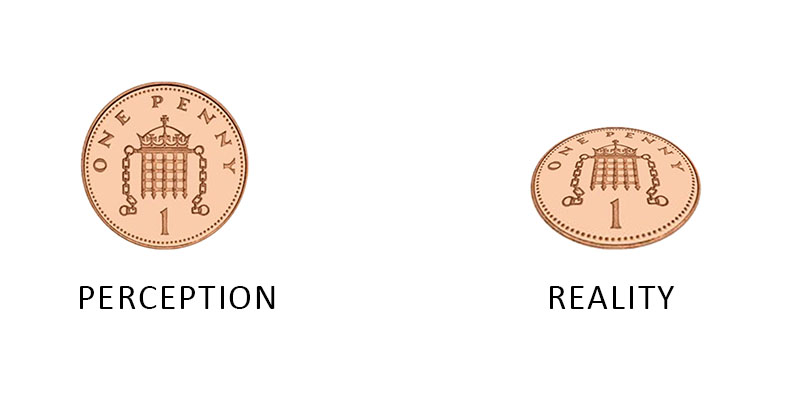What is Visual Accuracy?
However, there are many instances where what is actually seen by the eye is re- interpreted by the brain, giving rise to various myths and misconceptions about visual accuracy.
Myth: The Camera Never Lies vs Fact: The Camera Seldom Tells the Truth
There is a commonly held belief that ‘the camera never lies’. The fact is that the camera seldom tells the truth. The best we can hope for is that for one moment in time, from one perspective, a camera may capture an image that offers a semblance of the truth about the subject in front of the camera.
Explaining Away the Myth ‘The Camera Never Lies’
Outside the captured image either in timing, or what is or isn’t included in the image frame, there may exist details that would change our understanding of the image. Or the truth may be hidden behind colours, brightness or shadows within the image.
Misconception: ‘Seeing is Believing’ vs Fact: ‘Seeing is Perception’
Another commonly used, but totally erroneous phrase is, ‘seeing is believing’. This phrase should rather be reinterpreted as ‘seeing is perceiving’.
The reality of what is actually captured by the eye may not be translated into a true representation by the brain; what is perceived by the brain is not infallible. We should understand that the perception of what is seen is the result of experience and training.
The Logic Behind ‘Seeing is Perceiving’
Our eyes and brains experience thousands, hundreds of thousands, even millions of ‘objects’ each day. The brain has to rapidly convert a variety of shapes and colours into a useful understanding of the world around us.
However, to achieve a rapid conversion of the objects into something that we can comprehend and react to, or interact with, the brain doesn’t actively process all the points of data. Instead shortcuts and visual cues which have been learned from birth come into play, giving us an image that is only partially based on what the eye sees.
This way in which our eyes and brains interact, allows us to quickly and smoothly interpret visual objects, making daily actions such a brewing a cup of tea, reading an article in the newspaper, and then driving to work, all happen quickly and efficiently.
The Proof Behind ‘Seeing is Perception’
Try this:
Take a round coin and place it flat on the desk in front of you. Close one eye. With the other eye look at the coin What shape do you see? Is it a circle?
Unless you are sitting directly over the coin, the shape captured by your eye is not a circle but an oval, caused by the effect of perspective. However, years of experience of circular coins means our eyes and brains are pre-programmed to understand this shape as a circle and so we do.

This simple example demonstrates that there is a difference between what we actually see and what we think we see. Hence the need to perceive the subject properly.
Myth: 2D Monitors Show Reality vs Fact: A Single Point of Perspective Is Not Always Enough
The first myth we covered was ‘The Camera Never Lies’ but we know that, in essence, it doesn’t necessarily tell the full truth. In the context of three- dimensional subjects, this is even more the case.
We commonly use 2D screens to display images of 3D subjects, believing that we understand the 3D nature of a subject. Our experience and training has led us to trust that we can view these items ‘properly’, however this is not the case.
 Using a Single Point for Perspective
Using a Single Point for Perspective
When we choose a 2D display media we choose one point for perspective. By doing so we can create a situation where the impossible shape appears to become possible, producing an optical illusion. It’s only when we change our perspective that we understand the real nature of the subject.
The Penrose triangle provides a great example of how easily our eyes can be fooled.
Below the Penrose triangle looks correct from one point of view but is clearly not from another.
Other Common Optical Misconceptions
- Confusion between discolouration and indents or raised points. In some instances, an area of discolouration can be mistaken for shadow caused by an indent or raised area.
- Confusion between distortion and perspective. Where a distorted subject is perceived to be simply viewed at an angle or vice versa.
- Confusion between an item being proud or recessed into another subject.
Why You Should Add Another Perspective
There is a simple way to overcome the misconceptions caused by a single point of perspective. Using a 3D display system enables another perspective to be added to the object in view.
Revisiting the earlier example of the coin, the addition of 3D doesn’t stop the distortion in what is captured by the eye. Rather 3D allows each eye to see the object with a slightly different perspective and by combining the difference between the views from one eye to the other, the user is able to clearly perceive the shape of the subject.
How a 3D View Improves the Inspection Process
There are a range of visual cues which contribute to the understanding of an object. When viewing a static 3D object in 2D there are only a limited number of visual cues available to help us understand the subject. Viewing 3D subjects in 3D greatly enhances our understanding of the subject and it’s depth as well as length and height.
This improved depth perception allows a microscope user to easily understand the difference between a shadow and a raised or recessed area of a component, thereby improving the speed and accuracy of visual inspection routines, for instance when inspecting features such as inner threads within a component.
Additionally, improved depth perception is particularly useful in instances where tasks such as soldering and re-working are required.
The introduction of a 3D perspective also provides a greater understanding of convergence and texture.
The ability to understand the texture of a component is particularly valuable in instances where a surface finish is part of the visual inspection regime. In many high value medical device components a fine, smooth surface finish is critical to a part meeting compliance requirements, making 3D inspection a must-have.
Vision Engineering’s DRV-Z1 is a revolutionary digital stereo 3D viewer with zoom that delivers a 3D view with strong depth perception, sharp detail and rich colour and contrast. The DRV-Z1 not only provides an exceptional 3D image but also provides the capability to capture and share 3D images in real-time. When it’s important for you to ‘believe what you see’ the DRV-Z1 provides excellent visual accuracy, ensuring quick and accurate quality control.



